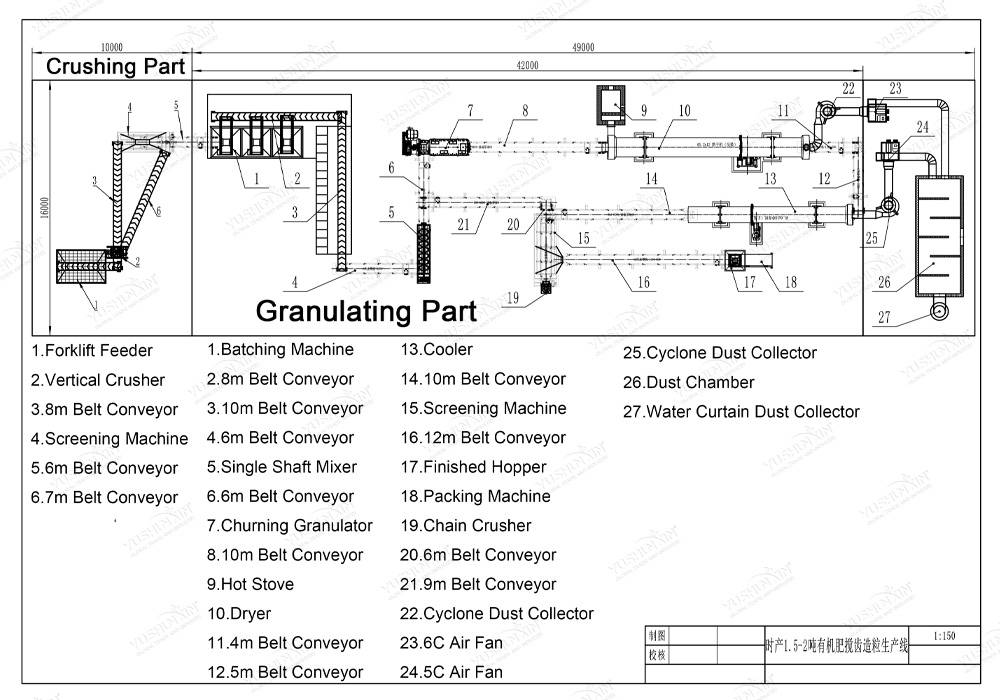







วัตถุดิบปุ๋ยอินทรีย์ทั่วไป
1. ปุ๋ยคอกปศุสัตว์
– มูลไก่: ปริมาณไนโตรเจนสูง, การแสดงที่รวดเร็ว, แต่จำเป็นต้องได้รับการย่อยสลายอย่างเต็มที่เพื่อหลีกเลี่ยงการเผาพืช.
– มูลหมู: สมดุลในสารอินทรีย์และสารอาหาร, ใช้กันทั่วไปเป็นวัสดุปุ๋ยอินทรีย์.
– มูลวัว: ปริมาณเส้นใยสูง, สลายตัวช้าๆ, เหมาะสำหรับการผสมกับวัสดุไนโตรเจนสูง.
– ปุ๋ยคอก: ปริมาณสารอาหารสูง, ด้วยเอฟเฟกต์การปฏิสนธิปานกลาง.
2. ผลพลอยได้จากอุตสาหกรรม
– ธัญพืชที่ใช้แล้ว: สารตกค้างที่เหลือหลังจากการต้ม, อุดมไปด้วยสารอินทรีย์และไนโตรเจน.
– สารตกค้างจากโรงงานน้ำตาล: เช่นชานอ้อยและหัวผักกาด, ปริมาณคาร์บอนสูง.
– ขยะแปรรูปอาหาร: รวมถึงผลพลอยได้เช่นถั่วเหลือง, เยื่อผลไม้, แป้งตกค้าง, เป็นต้น, ง่ายต่อการย่อยสลายและอุดมไปด้วยสารอาหาร.
3. ขยะเกษตรกรรม
– ฟางพืช: เช่นข้าวโพด, ข้าวสาลี, ฟางข้าว, เป็นต้น, อุดมไปด้วยเซลลูโลสและอินทรีย์.
– เปลือกผลไม้และเยื่อกระดาษ: เช่นเปลือกถั่วลิสง, หอยมะพร้าว, สารตกค้างอ้อย, เป็นต้น, อัตราส่วนคาร์บอนต่อไนโตรเจนสูง, เหมาะสำหรับการปรับอัตราส่วนคาร์บอนไนโตรเจนในการทำปุ๋ยหมัก.
– ผักและผลไม้ของเสีย: เช่นใบผักที่เสีย, เปลือกผลไม้, เป็นต้น, ง่ายต่อการย่อยสลาย, แต่ควรใช้ความระมัดระวังด้วยความชื้นสูง.
4. ขยะอินทรีย์ในเมือง
– ขยะในครัว: อุดมไปด้วยสารอินทรีย์และสารอาหาร, แต่ควรแยกออกจากน้ำมันและสิ่งสกปรก.
– กากตะกอน: กากตะกอนบำบัดน้ำเสีย, ต้องปราศจากการปนเปื้อนโลหะหนัก.
– ขยะในสวน: เช่นใบไม้ที่ร่วงหล่น, กิ่งไม้ตัดแต่ง, เป็นต้น, ปริมาณคาร์บอนสูง.
5. วัตถุดิบอื่น ๆ
– เห็ดตกค้าง: สารตั้งต้นของเสียหลังการเพาะเห็ด, อุดมไปด้วยสารอินทรีย์.
– เค้กน้ำมัน: เช่นเค้กถั่วเหลือง, เค้กเรพซีด, เป็นต้น, ไนโตรเจนสูง, ทำให้พวกเขาเป็นวัตถุดิบปุ๋ยอินทรีย์คุณภาพสูง.
– สาหร่ายทะเล: อุดมไปด้วยแร่ธาตุและฮอร์โมนการเจริญเติบโต, เหมาะสำหรับการผลิตปุ๋ยอินทรีย์ระดับไฮเอนด์.
หลักการสัดส่วนวัตถุดิบ
1. อัตราส่วนคาร์บอนต่อไนโตรเจน (C/N) การปรับ
– อัตราส่วนคาร์บอนต่อไนโตรเจนในอุดมคติคือ 25:1~ 30:1.
– วัสดุคาร์บอนสูง (เช่น, หลอด, ชิปไม้) ควรผสมกับวัสดุไนโตรเจนสูง (เช่น, ปุ๋ยคอกปศุสัตว์, เค้กถั่วเหลือง) เพื่อปรับสมดุลอัตราส่วน C/N.
2. การควบคุมความชื้น
– ควรควบคุมปริมาณความชื้นของวัสดุระหว่าง 50% และ 60%. ความชื้นสูงหรือต่ำเกินไปจะส่งผลต่อกระบวนการหมัก.
3. การปรับค่า pH
– ในระหว่างการหมัก, ควรรักษาค่า pH ระหว่าง 6.5 และ 8.5. สามารถเพิ่มสารมะนาวหรือกรดเพื่อปรับค่า pH ได้.
4. การเพิ่มจุลินทรีย์หมัก
– การเพิ่มตัวแทนจุลินทรีย์ (เช่น *Bacillus subtilis *, *Actinomycetes*, เป็นต้น) สามารถเร่งกระบวนการหมักและปรับปรุงประสิทธิภาพการทำปุ๋ยหมัก.
1.Low investment cost: simple equipment, less initial investment.
2.Short process flow: no need for granulation, more efficient production process.
3.การใช้พลังงานต่ำ: more energy-saving and environmentally friendly than granular fertilizer production.
4.Good nutrient retention: reduce processing loss and maintain organic matter activity.
5.Easy equipment maintenance: simple structure and low maintenance cost.
ต้นทุนของแต่ละสายการผลิตแตกต่างกันไปขึ้นอยู่กับกำลังการผลิต, ระดับของระบบอัตโนมัติ, และความต้องการเฉพาะ. กรอกแบบฟอร์มด้านล่างและเราจะให้ใบเสนอราคาที่ถูกต้องแก่คุณ!
หากคุณสนใจอุปกรณ์ทำปุ๋ยของเรา, โปรดส่งความต้องการและผู้ติดต่อของคุณแล้วเราจะติดต่อคุณภายในสองวัน. เราสัญญาว่าข้อมูลทั้งหมดของคุณจะไม่รั่วไหลให้ใคร.
- บริษัท ก่อตั้งขึ้นใน 2005 และมุ่งเน้นไปที่การวิจัยและพัฒนาและการผลิตอุปกรณ์ปุ๋ยอินทรีย์สำหรับ 20 ปี. มันได้สร้างฐานการผลิตอุปกรณ์ปุ๋ยขนาดใหญ่ 40,000 เมตรฐานการผลิต, ใช้แกรนูลขั้นสูง, เทคโนโลยีการอบแห้งและการคัดกรองเพื่อปรับปรุงประสิทธิภาพการผลิตและคุณภาพของผลิตภัณฑ์.
- องค์กรนำเข้าและส่งออกที่ดำเนินการด้วยตนเองด้วยมากกว่า 80 วิศวกรมืออาชีพทั่วโลก, ให้บริการมากกว่า 100 ประเทศและภูมิภาคต่างๆทั่วโลก, 5,000+ กรณีการบริการลูกค้า, 10 ศูนย์ประมวลผล, 3 เครื่องตัดเลเซอร์, และมากกว่า 60 อุปกรณ์ประเภทต่างๆ.
- รักษาความร่วมมือระยะยาวและกว้างขวางกับสถาบันวิจัยทางวิทยาศาสตร์และมหาวิทยาลัยหลายแห่ง, with a professional R&D team, สามารถเพิ่มประสิทธิภาพของอุปกรณ์อย่างต่อเนื่องตามความต้องการของตลาด.
- วัสดุทนต่อการสึกหรอสูง, เลือกคาร์บอนเหล็ก Q235/โลหะผสมเพื่อให้แน่ใจว่าอุปกรณ์มีความทนทานและลดค่าใช้จ่ายในการบำรุงรักษา.
- การใช้ระบบควบคุมอัจฉริยะเพื่อปรับปรุงระดับการผลิตอัตโนมัติและลดการพึ่งพาด้วยตนเอง.
- ISO, CE, การรับรอง SGS International
- ด้วยกำลังการผลิตขนาดใหญ่, สามารถตอบสนองความต้องการด้านกำลังการผลิตที่แตกต่างกัน (เล็ก, สายการผลิตขนาดกลางและขนาดใหญ่).
- รุ่นอุปกรณ์เต็มรูปแบบ, เหมาะสำหรับการผลิตปุ๋ยชนิดต่าง ๆ เช่นปุ๋ยอินทรีย์, ปุ๋ยผสม, ปุ๋ยชีวภาพ, ปุ๋ยที่ละลายน้ำได้, ปุ๋ยเหลว, ฯลฯ.
- การออกแบบส่วนบุคคลสามารถให้ได้ตามความต้องการของลูกค้า, รวมถึงกำลังการผลิต, เค้าโครงไซต์, มาตรฐานการคุ้มครองสิ่งแวดล้อม, ฯลฯ.
- ให้ชุดโซลูชั่นสายการผลิตที่สมบูรณ์, รวมถึงการเลือกอุปกรณ์, การติดตั้งและการว่าจ้าง, การฝึกอบรมด้านเทคนิค, ฯลฯ.

- อุปทานโดยตรงจากโรงงาน, การลดลิงก์มิดเดิลแมน, และราคามีการแข่งขันมากขึ้น.
- อุปกรณ์มีประสิทธิภาพการใช้พลังงานสูง, ลดการใช้พลังงาน, และช่วยให้ลูกค้าลดต้นทุนการดำเนินงานระยะยาว.
- อุปทานโดยตรงจากโรงงาน, การลดลิงก์มิดเดิลแมน, และราคามีการแข่งขันมากขึ้น.
- อุปกรณ์มีประสิทธิภาพการใช้พลังงานสูง, ลดการใช้พลังงาน, และช่วยให้ลูกค้าลดต้นทุนการดำเนินงานระยะยาว.